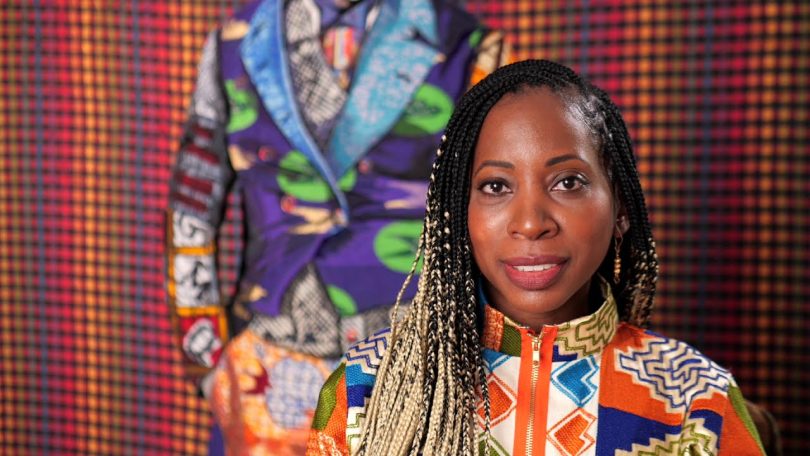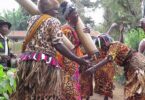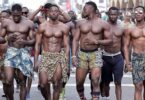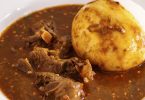Bisa Butler, an African American, is not your average fiber artist. Her reputation transcends her image in every way, shape and form.
She altered the quilting medium by developing a new genre. Although quilting is traditionally regarded as a craft, her interdisciplinary techniques birthed a craft of international repute.
Born Mailissa Yamba Butler in 1973, she propelled quilting into the realm of high art by producing quilts that resemble paintings. Her fame stems from creating vibrantly beautiful, larger-than-life quilted portraits that enthral visitors everywhere.
The daughter of a French teacher and a college president is also the youngest of four children all raised in South Orange.
Butler received a blue ribbon in an art competition when she was four years old, marking the beginning of her artistic aptitude. She has a fine art from Howard University.

Bisa Butler displaying her quilt portrait. Photo/BBC
It is in Howard University that Bisa Butler honed her innate art talents. She started experimenting with fabric as an art medium and developed an interest in collage methods.
In 2005, she graduated with a Master’s in Art from Montclair State University. Butler would then pursue a fiber arts course while working on her Master’s degree. This was the time she realized that this was a perfect platform to express herself.
Table of Contents
What Techniques Does Bisa Butler Use?
The 49-year-old combines the African American experience to create her enthralling artistic work. Her vibrant quilts reinterpret vintage portraits.
She enlarges a photo to life-size before sketching over it to separate out the light and dark portions. Then, she starts the appliqué process by picking her materials, stacking them, and sewing them together.
In the end, soft batting and a backing cloth are put on top of the embroidered portrait. It can take hundreds of hours to finish one quilt.
Colour abounds in Butler’s quilts, and each fabric has a special significance. She conveys that her characters are of African heritage. They have a long, rich history behind them using West African wax printed fabric, kente cloth, and Dutch wax prints.
She uses a bright technicolor cloth to depict her skin tone. It is symbolic of the Black culture.
Bisa Butler never employs natural skin tones because, as an African American, she describes her complexions with these colours.
How Does Bisa Butler Make Her Quilts?
Butler gives her black subjects—those she finds in old images as well as members of her own family—dignity and respect using her distinctive artistic approach, which mixes portraiture with quilting.
The fabric pieces are held in place by several pins and “little taps” of adhesive. The figure or figures are added to the batting, backing fabric, and background materials.
She fashions striking portraits that reinvent and celebrate Black life narratives and are totally made of brightly colored and patterned fabrics.
Reimagining the captured people as attentive portraits with layers of color and stitched features using photographs as the source images. She carefully chooses textiles, reinforcing the narratives she intends to convey in each one through the imagery or history of the designs.

Bisa Butler’s quilt portrait. Photo/PBS
Bisa Butler brings to life historical and personal accounts of Black life by layering materials and meanings. In doing so, she challenges viewers to look closely and reflect carefully on the potential and goals of portraiture.
How Much is a Bisa Butler?
Realized values vary from 37,500 USD to 75,000 USD depending on the size and medium of the artwork. Her work featured in art auctions numerous times. Nandi and Natalie (Friends) sold at Swann Auction Galleries in 2021 and fetched the artist’s highest auction price of 75,000 USD.
Where Can I See Bisa Butler Quilts?
The Art Institute of Chicago is one of those places where you can view Bisa Butler’s quilts. She displayed 22 quilts in September 21. She also has a website www.bisabutler.com where she has some of her work on display.








